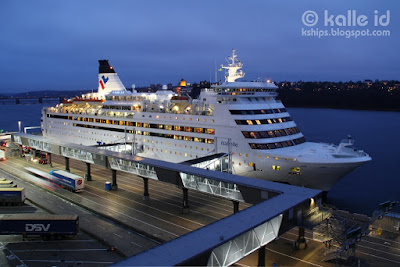Silja Serenade
IMO 8715259
Built 1990, Masa-Yards Turku New Shipyard, Finland
Tonnage 58 376 GT
Length 203,03 m
Width 31,93 m
Draught 7,12 m
Ice class 1A Super
2 852 passengers
3 001 berths
410 cars
1 600 lane metres
4 Wärtsilä-Vasa diesels, combined 32 580 kW
2 propellers
2 bow thrusters
1 stern thruster
Speed 21 knots
Once again, the new interiors of the various public space are the work of the Finnish interior design firm Aprocos, who have pretty much become Tallink's designers of choice. Interestingly enough, Aprocos' founder and CEO Heikki Mattila had already worked on the original interiors of these ships.
Starlight and the Seaview Lounge on Decks 7 and 8
The former Atlantis Palace show lounge and casino complex, forward on decks 7 and 8, which previously survived nearly in original condition, has been finally given a thorough refit, which included new staircases, replacing three old bars with two new ones, and an increased number of seats especially in the forward viewing area (now called the Seaview Lounge, whereas it was previously just the Bow Bar). Unfortunately, during the press visit the Starlight complex was not entirely complete, most notably lacking the various plants that are an integral part of the final design.
 |
| The tiered seating is where the space retains most of its original appearance, but gone are for example the seashell-shaped lamps. |
 |
| The Great Gatsby. |
Further aft along the Promenade, the Bon Vivant fine dining restaurant, wine bar and the adjacent wine shop have also been redecorated (and it was about time too).
 |
| I'm afraid the lighting here didn't quite agree with my camera, and the vibrant dark blue of the chairs and carpets ended up looking grey instead. |
Grill House on Deck 7
Further aft, the popular El Capitan grill restaurant has given way to the Grill House, a similarly themed restaurant already found onboard many other Silja Line and Tallink ships. Gone is the 1990s fax mexicana and in is a more refined grill restaurant (though I must say that my favourite Grill House remains that onboard the Silja Europa – also designed by Aprocos).
 |
| I wasn't a fan of El Capitan, but here I could eat just for the decor. |
 |
| I really show have cleared that plate away. |
This space wasn't actually added in the most recent refit, but in the 2015 one (I think). As it has not featured here before I thought I would put it in anyway. This space used to be the children's playroom back in the day, but that was moved to larger premises down on Deck 5 (my son loves the place), so a new cafeteria could be inserted here.
 |
| This place is, alas, where the Serenade loses to her younger sister Silja Symphony, as that ship has a sushi restaurant – one of the best I've eaten in outside Japan – instead. |
Previously, the pub aft on the promenade was named Old Port Pub and in my books, it was one of the gloomiest, least pleasant spaces onboard. The new Sea Pub is much lighter, airier and generally more pleasant (but it must be said it isn't quite as good as its cousin onboard the Silja Symphony in my books, as on that ship it's even nicer and less publike).
 |
| This is a pub I might consider visiting. The old incarnation wasn't. |
All over the ship, the stairwells, lobbies and corridors have been given a new look, including new carpets, a new colour scheme and new artworks. And it was about time, as these were areas where the original look of the ship survived. And while it feels silly to put money on these things, as they don't really generate money, they are also some of the first places the passenger sees when coming onboard and will effect how they judge the entire ship.
 |
| This is just so much better than the old one. I kind of feel bad about the originals artworks in the staircases... but then again, they weren't particularly impressive, so I won't really miss them. |











